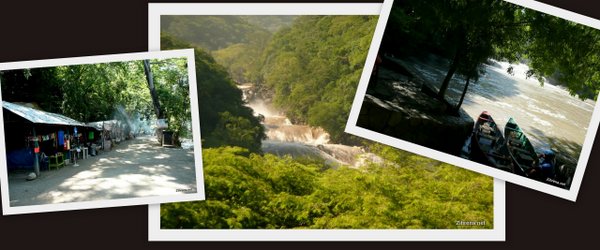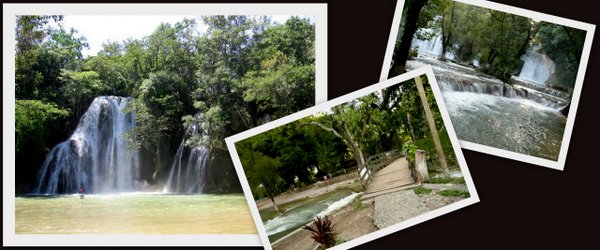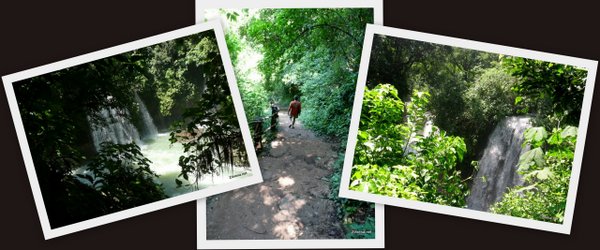Waterfalls of the Huasteca Potosina
The Huasteca, part of which lies along the eastern slopes of the Sierra Madre Oriental and runs down to the Gulf Coast along the basin of the Rio Panuco (Panuco River) in Mexico, is incredibly rich in water resources, and the landscape and vegetation testify to that richness.
Within the area of the Huasteca are numerous and spectacular waterfalls, many of which are easily accessible to the regular visitor; others, such as the Cascada de Tamul, may require considerable physical effort and a bit of an adventuresome spirit to visit.
Cascada de Micos

The Cascada de Micos, also called Salto Micos or the Cascadas de Pago Pago, is located on a secondary road north of Ciudad Valles on Rio El Salto. This waterfall is really a series of seven cascades with drops of up to eight meters in height.
We visited the falls in the rainy season when the river was swollen and muddy and the volume of water much too great for anyone but experts to be out on it except to paddle around the waterlogged tree trunks near the shore. We were told that during the winter season, when the waters are calmer and clearer, the favorite pastime here is el salto de cascadas or “jumping the falls,” in which the adventuresome leap over every one of the seven falls–wearing helmets and life vests, of course.
This was not a spectacular set of falls for a rainy season visit. Nevertheless, we enjoyed our walk around the pathways that snaked alongside the river, where the high waters were overrunning the banks in several places, and enjoyed tacos made with handmade corn tortillas and fillings hot off wood-fired grills whose fragrant smoke mimicked the mist from the waterfall.
Cascadas de Tamasopo

Taking the back roads from Salto Micos to Tamasopo, we drove through hills and valleys and the villages of Rascon and Tambaca. It was no quick shot as the secondary road was well pitted with surprise potholes and riddled with rainy-season washboards, but the terrain was relatively flat and the drive simply took a bit more steering muscle and close attention than the highway would have. The landscapes, wreathed in green, were quite spectacular.
If you take the highway out of Ciudad Valles, turn off to Tamasopo at kilometer 55. The falls are about seven kilometers from the junction.
At the picturesque Tamasopo falls just outside of the town of the same name, the water plummets and sprays into a series of pools and streams that can be enjoyed by bathers and waders (if you like crisp, cold water!). There are bridges and walkways and cool stretches of grass shaded by trees. The remains of an aqueduct that carried water to power a sugar mill waterwheel dating from around the turn of the twentieth century are still standing on the property.
Despite it being rainy season, Tamasopo’s streams were quite clear with waters of an only slightly milky green-turquoise hue.
Puente de Dios

Not far from the Tamasopo Falls is Puente de Dios, or the Bridge of God. It is located in the small community of El Cafetal, also on the Tamasopo river above the Tamasopo Falls. The road in from the town of Tamasopo is largely gravel, yet even with the rains we were able to access it easily in our low-slung Volkswagen.
Here the tremendous force of the Tamasopo river has carved its way between and under huge boulders creating a spectacular bridge-like formation. The sound of the water coming from the depths of the chasm as you walk down the steep path is like thunder. Spray rising from the spewing cascades showers you even on a dry day as the water tumbles into great, rounded natural pools below.
You need to be sure of foot to make your way down to the bridge, and you do need a bit of stamina to make your way slowly back up to the town level, but it is definitely worth the effort. When we were there, water was seeping out of the saturated ground as well as being hurled over the precipices of the falls. There was a lush undergrowth everywhere and, in certain areas, bright orange butterflies amassed on the rich, moist earth.
Cascada de Tamul
Certainly one of the most incredible of Mexico’s waterfalls is the Cascada de Tamul, located at the confluence of the Gallinas and Santa Maria rivers, which join to form the Rio Tampaón. These falls can measure up to 300 meters in width, depending on the season, and plummet some 105 meters from the level of the Gallinas River to that of the Rio Santa Maria, or Tampaón.
We approached this marvel from the direction of Aquismón, San Luis Potosi, hoping to gain access by boat via the Tampaón River. We were warned in Aquismón that that it wasn’t recommendable to approach the falls at this time of year because of the height of the raging waters; nevertheless, we wanted to give it a try.
After slowly traveling an almost deserted highway, we found ourselves in a small community near the river where we were offered a boat to take us to the falls. The men there told us that the waterfall was, indeed, approachable and that they could take us, but because of the high water levels and force of the torrent, the normally one-hour boat ride (each way) would take at least two. They also warned us that, because of the strong current from those high water levels, the cost for the boat would be double the normal, since extra rowers were needed to propel us upriver in the small, wooden, motorless craft.
Well, that clinched it for us. We looked at each other, shook our heads, thanked our friendly would-be guides for their help, and returned to the car and to the road. The Cascada de Tamul would just have to wait for some other dry season trip through the Huasteca!
Sources and further info:
- Colaboradores de Wikipedia, “Cascada de Tamul,” Wikipedia, La enciclopedia libre, http://es.wikipedia.org/w/index.php?title=Cascada_de_Tamul&oldid=70097887 (descargado 20 de mayo de 2014).
- “La Huateca potosina,” La Jornada Viajera, http://www.jornada.unam.mx/viajera/?destino=san%20luis%20potosi